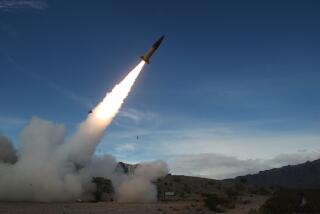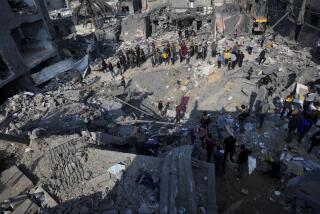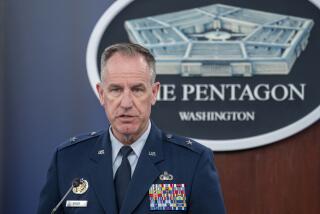When It Comes to Artillery, U.S. Is Outgunned by Enemy’s Weaponry : Military: The Korean War was the last time the United States had clear dominance.
Aerial bombardment continues to take its toll in the allied air campaign against Iraq, but another kind of bombardment is yet to come. “It is with artillery that war is made,” said Napoleon Bonaparte, and casualty figures from America’s most recent wars still bear him out.
In World War II, shrapnel (fragments from exploding artillery shells) caused 53% of U.S. battle deaths and 62% of the wounds. In Korea, shrapnel caused 59% of the deaths and 61% of the wounds. Even in the close-quarter fighting in the jungles of Vietnam, where enemy rifle and machine-gun fire caused the majority of deaths, enemy shell fragments still caused 36% of the deaths and 65% of the wounds.
And the prospect is that if it comes to a ground war in the Persian Gulf, those figures may be even higher, because since the Korean War the U.S. military has allowed itself to become both outgunned and outranged in field artillery. Indeed, the Korean War was the last time the United States had clear artillery dominance.
Artillery assigned to the several U.S. infantry divisions and the 1st Marine Division in Korea included 105-millimeter and 155-millimeter howitzers, longer-range 155-millimeter “Long Tom” guns and eight-inch (203-millimeter) howitzers in general support.
Howitzers fire shells in a high-arc trajectory compared to the relatively flat trajectory produced by long-barreled artillery. Late in the war, two 240-millimeter howitzer battalions, whose guns originally were designed to demolish such fortifications as Nazi Germany’s Siegfried Line, were also sent to Korea. They could literally lay down a wall of fire.
For instance, when the Chinese Communist forces’ 27-division spring offensive struck the allied lines in April, 1951, a total of 158,303 tons of artillery ammunition was fired to turn back the attack. The logistics effort to sustain that rate was prodigious: 27 Liberty Ship loads of ammunition, or the equivalent of 3,332 rail cars.
Although the Chinese and the North Koreans had little artillery at the beginning of the war, they had almost 1,000 artillery tubes by the end. In July, 1953, they fired 375,565 rounds at allied positions. Allied guns fired 2,710,248 rounds in June, 1953, and 2,000,982 rounds in July.
In Vietnam, the United States, despite its preponderance in numbers of in-field artillery, found itself outranged by the North Vietnamese army’s Soviet-supplied 130-millimeter guns. The range, more than 30 kilometers (18 miles), supposedly was matched by the U.S. Army’s M-107 175-millimeter guns, but enemy guns were far more accurate than their U.S. counterparts.
During the siege of Khe Sanh, for example, the Marines had their 105-millimeter and 155-millimeter howitzers dug in to provide supporting fire. But the North Vietnamese had 130-millimeter guns entrenched across the border in Laos far out of range of the Marine howitzers. On Feb. 23, 1968, the North Vietnamese slammed 1,307 rounds of artillery, mortar and rocket fire into the Marine base.
Although knowing their rounds would fall far short, the Marine gunners fired counterbattery salvos, satisfying, at least psychologically, their desire to hear some outgoing fire. But it was Air Force and Marine fighters and bombers that finally silenced the enemy guns.
The Soviets, who supplied these weapons to North Vietnam, have supplied them to Iraq as well. That’s bad news for the two U.S. Marine divisions in Saudi Arabia, as well as the Army’s 82nd Airborne Division and 101st Airmobile Division. They are still armed with towed 105-millimeter howitzers with a range of from 11.5 to 18 kilometers (approximately 7 to 11 miles) as their direct support artillery, still far short of the Iraqis’ 130-millimeter guns, with a range of more than 30 kilometers. And even the U.S. general-support 155-millimeter howitzers are not quite in range.
The U.S. Army’s armored and mechanized divisions are in somewhat better shape. Their principal direct support, the M-109A2 self-propelled 155-millimeter howitzer, has a range of from 18 to 23.5 kilometers (11 to 14 miles), and their general support MLRS (multiple-launch rocket systems), with standard 227-millimeter missiles, have a range in excess of 30 kilometers and can be fitted with an ATACMS (army tactical missile system) rocket that has a range of more than 100 kilometers (60 miles).
The most accurate howitzer in the U.S. inventory is the eight-inch, self-propelled howitzer that can extend its 22.5-kilometer range out to 30 kilometers when firing a rocket-assisted projectile. These are in short supply and, to make matters worse, in an incredible display of bureaucratic stupidity, the eight-inch battalion that normally supports the 3d Armored Division, now deployed in the gulf, is being demobilized in Germany as an “economy” move.
What causes allied artillerymen the most concern, however, is not the Soviet-supplied 130-millimeter gun but the approximately 300 South African and Austrian-supplied G-5 and GHN-45 gun-howitzers. Firing a particularly effective high-fragmentation shell that can produce a shrapnel shower, it has an incredible range of 45 kilometers, far exceeding that of any U.S. or allied tube artillery.
As at Khe Sanh, there is the prospect of U.S. troops pinned down by enemy artillery fire, with their own artillery outranged and unable to silence enemy guns. And what makes it even worse, Iraqi artillery not only outranges but also outnumbers the allied artillery. With more than 3,700 guns, howitzers and multiple rocket launchers deployed in support of their maneuver forces, Iraq more than doubles the allied artillery. And Iraq can put chemical shells on its larger artillery.
How did the United States get in such a fix? Instead of concentrating on conventional artillery, the U.S. Army became enamored of nuclear weaponry, putting its time and money into now worthless nuclear rounds for its 155-millimeter and eight-inch howitzers and developing its Lance and Pershing nuclear missile systems. Only recently did it come to its senses and begin a howitzer improvement program, too late to do any good in the Persian Gulf.
Iraq, on the other hand, has been working on improving its conventional artillery for a long time. According to the Toronto Globe and Mail, beginning 10 years ago Hussein took advantage of the genius of Canadian arms designer Gerald Bull, who reportedly had been rebuffed by the U.S. military. Iraq not only acquired about 300 Bull-designed G-5 and GHN-45 155-millimeter gun-howitzers but also two new Bull-designed guns, the 210-millimeter Al Fao, rated as the most powerful artillery piece in the world, with a range of 45 kilometers (about 28 miles), and the smaller 155-millimeter Majnoon, which has a 30-kilometer range. The Al Fao is the only self-propelled system of its caliber in the world.
The United States traditionally has compensated for its lack of long-range artillery, as at Khe Sanh, through battlefield air interdiction and close air support. Thus, Iraqi artillery is one of the major targets of the ongoing allied air campaign, and will remain a priority air target when the ground campaign begins.
Suppressing enemy artillery will not be an easy task, for as the British Tornado fighter-bombers found in their low-level attacks on Iraqi airfields, the Iraqis have a formidable machine-gun and cannon antiaircraft-artillery air defense system. But it is a job that will have to be done, for when it comes to land battle, it is still true, as Napoleon reputedly emphasized, that “God fights on the side with the best artillery.”
More to Read
Sign up for Essential California
The most important California stories and recommendations in your inbox every morning.
You may occasionally receive promotional content from the Los Angeles Times.










